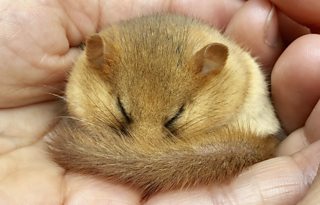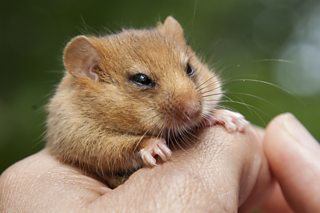How connecting landscapes can help hazel dormice
People's Trust for Endangered Species (PTES)
Partner organisation of the Watches
With their soft golden coat, furry tail and big black eyes, hazel dormice are one of Britain’s most endearing but critically endangered mammals.
Our State of Britain’s Dormice report in 2016 confirmed that hazel dormice have become extinct from 17 English counties since the end of the 19th century, with populations thought to have fallen by a third since 2000 - a rate of decline equivalent to 55% over 25 years.

A close up of a sleepy hazel dormouse during a reintroduction. Photo by Clare Pengelley
Loss of woodlands and hedgerows and a decline in traditional countryside management practices can be attributed to this decline, but sadly, numbers are still falling.
To thrive, dormice need well-managed woodlands connected by hedgerows that allow populations to spread. Since we began our annual reintroduction programme in 1993, over 900 dormice have been released into woodlands in 12 English counties where they once existed, in an effort to rebuild lost populations. We also manage the national monitoring programme for dormice and train woodland owners on managing woodlands empathetically for dormice.
One fantastic example of how woodlands can be managed to help this endangered species comes from the Yorkshire Dales National Park. Dormice were extinct in Yorkshire, but in 2008 and 2016 we reintroduced two new populations to different (but close) sites in Wensleydale, to re-build a hazel dormouse foothold in the county. When we carry out these reintroductions, we aim to do two or three in close proximity and restore the connective landscape of hedgerows in between them so that the populations can meet and mate.

A hazel dormice in woodland on the Isle of Wight. Photo by Clare Pengelley
This spring, a team from the Yorkshire Dales National Park Authority planted a total of 750 metres of hedgerow, to help expand the territory of the reintroduced hazel dormice. This new hedgerow will mature into a ‘highway’ for dormice, allowing them to move between different areas of woodland and hopefully connect up with the other reintroduced population, further down the line.
The hedgerow planting project was a three-year project – now entering its last year – supported by grants of £75,000 from the People’s Trust for Endangered Species (PTES) and nearly £48,000 from Yorkshire Dales Millennium Trust. Eventually we will have restored and created a significant landscape fit for dormice to thrive.

Dormice reintroductions and properly managed woodlands could see a brighter future for this charismatic species. Photo by Clare Pengelly
We know a loss of hedgerow, a key habitat for dormice as well as so many other wildlife, and lack of woodland management has contributed to the decline of this charismatic species. But, we are hopeful that the more projects like this take place, combined with correct woodland management practices, the more likely it is that dormice will come back to our landscape and hopefully remain in the area for at least the next hundred years.
.
